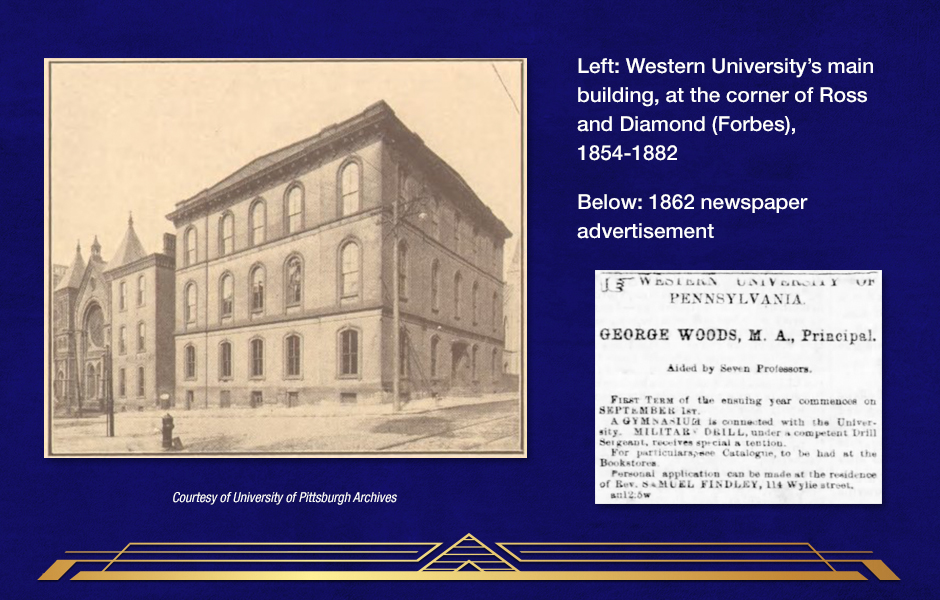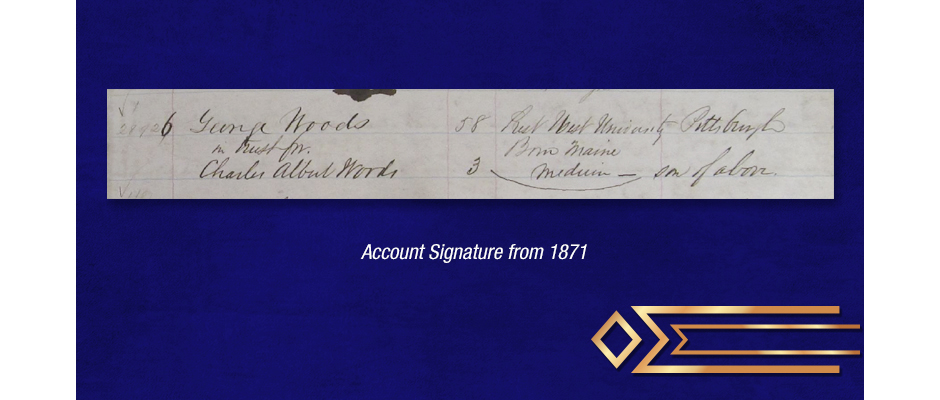George A. Woods
1813 – 1899
Educator and author Dr. George A. Woods served for 22 years as chancellor of the Western University of Pennsylvania (University of Pittsburgh) in the mid- to late-1800s. He was also a Sewickley resident for the last two decades of his life.
George Woods was born in the coastal community of Yarmouth, Maine to Elizabeth Baston and Joseph Woods, a carpenter. Through his mother, he was descended from Captain Winthrop Baston, a Massachusetts militia leader during the American Revolution. Woods’ parents maintained a large home library and supported the local North Yarmouth Academy, which George Woods attended after a primary education composed of a mixture of public, private and home schooling.
In 1833, Woods entered Bowdoin College. He graduated in 1837 with an excellent scholastic record and entered the teaching profession. For two years, he taught at Gorham Seminary in Maine, before moving to Tennessee, where he was professor of mathematics at Jackson College from 1839-1841. From 1841- 1850 he served as principal of his alma mater, North Yarmouth Academy. He led the Yarmouth Institute from 1850-1854 and Lewiston Falls Academy from 1855-1856.
In the 1850s, a busy lumber trade existed between Portland, Maine and Cuba. George Woods was acquainted with a number of the lumber merchants, who recommended the Yarmouth Institute to their Cuban counterparts. As a result, Dr. Woods’ school became host to around two dozen Cuban students – boys and young men ranging in age from eleven to twenty – during the brief life of the institute. Dr. Woods later recalled the Cuban youths as excellent scholars, disciplined and studious. Among those who were educated by Dr. Woods at the Yarmouth Institute were two future leaders in the Cuban War for Independence: Máximo Gómez and Calixto García.
In 1858, Dr. Woods was unanimously elected principal of the Western University of Pennsylvania. Dr. Woods accepted the appointment and moved his family to Pittsburgh.

When Dr. Woods assumed leadership of the university, its campus was downtown, and the enrollment totaled thirty-five students being taught by a handful of instructors. Under his leadership, the university grew and thrived. By 1875, students could choose studies in collegiate, scientific, engineering, military science, commercial and preparatory courses. Chemistry instruction with a lab for practice was also available to students, as was a library.
Dr. Woods’ title in 1859 was principal, but soon thereafter, the Pennsylvania Legislature changed the title of the school head to chancellor.
During Dr. Wood’s term, the university received one of the most important donations in the school’s history. In 1865, businessman William Thaw and a group of leading citizens gifted the university with Allegheny Observatory. What had started as a telescope club for local enthusiasts became a premier research facility, led by such renowned astronomers as Samuel Pierpont Langley and John Brashear.

In May 1880, after twenty-one years of service to the university overseeing tremendous growth and many changes, Dr. Woods informed the university’s Board of Trustees that he would not seek re-election as chancellor. At the time of his departure, Western University had seventeen instructors, several new buildings and endowed chairs, impressive engineering and scientific departments, and no debt.
Dr. George Woods received two honorary doctorates. The first, in 1863, was from Jefferson College (predecessor of Washington & Jefferson College in Washington, Pennsylvania). In 1878, a similar honor was conferred upon him by Bowdoin College.
Dr. Woods was married twice: in 1843, to Caroline Haynes, who died in the 1850s; and in 1864, to Ellen C. Crane. From both marriages there were six children who survived to adulthood. With his son, Edward A. Woods, Dr. Woods organized the Pittsburgh branch of the Equitable Life Assurance Society.
The Woods family moved to Sewickley in 1877, where they made their home on Thorn Street. Upon his death, Dr. Woods bequeathed a large collection of historical, mineralogical and paleontological samples to the Carnegie Museum.
Dr. Woods opened a savings account at Dollar Bank in 1871 in trust for his son, Charles Albert Woods.
